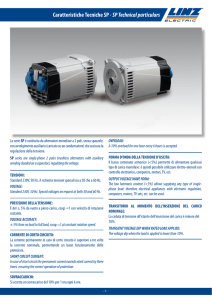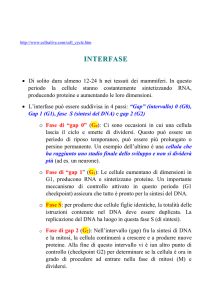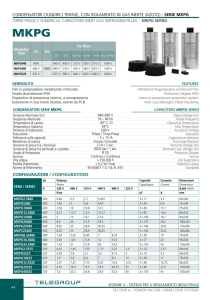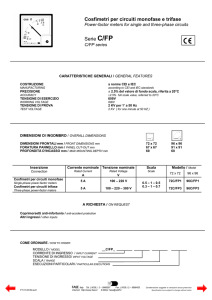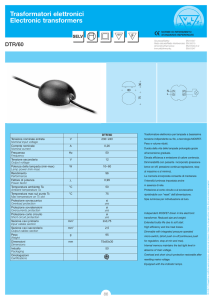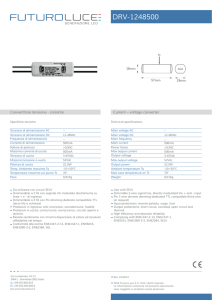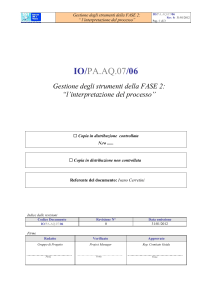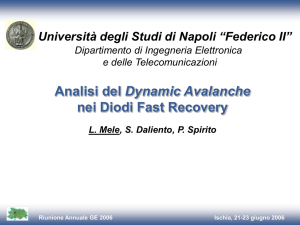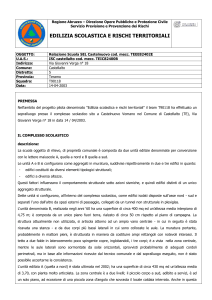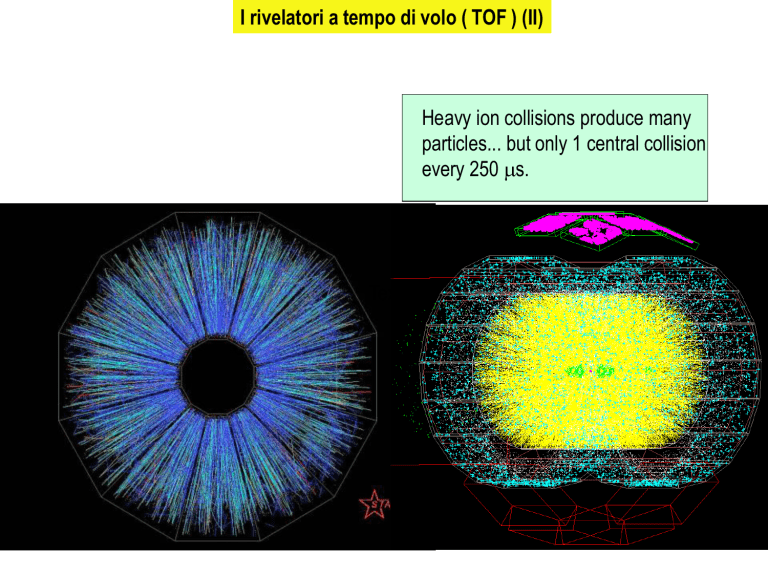
I rivelatori a tempo di volo ( TOF ) (II)
Heavy ion collisions produce many
particles... but only 1 central collision
every 250 ms.
Text
Concetto base dei rivelatori RPC (Resistive Plate Chamber)
Piani resistivi
2 mm
Volume di gas
Piani resistivi
Pad di lettura del segnale
Resistivita’ molto elevata (bakelite, vetro). Operava all’inizio in regime di streamer.
Ionizzazione primaria
COPPIE ELETTRONE - IONE POSITIVO
Processo di natura statistica
n
m
Pnm
e m
n!
N.B. np cresce all’incirca linearmente con Z del
gas
GAS (STP)
dE/ dx (keV/ cm)
n (ion pairs/ cm)
Helium Argon
0.32
6
2.4
29
Xenon
6.7
44
CH 4
DME
1.5
16
3.9
55
Ionizzazione secondaria
Gli elettroni della ionizzazione primaria
hanno energia sufficiente (keV) per
produrre una nuova ionizzazione
N/n ≈ 3 coppie elettrone-ione prodotte
n
coppie elettrone-ione primarie
GAS (STP)
n (ion pairs/cm)
cm)
N (ion pairs/cm)
Helium
Argon
6
25
8
90
Xenon
CH 4
DME
44
16
55
300
53
160
Moltiplicazione a valanga
•
•
Aumentando l’intensità
del campo elettrico (>10
kV/cm) gli elettroni
secondari possono
acquistare energia
sufficiente per produrre
una nuova ionizzazione
e così via con la
formazione di una
valanga
A causa della grande
mobilità degli elettroni
rispetto agli ioni positivi
la valanga ha la forma di
una goccia: sul fronte gli
elettroni, sulla coda gli
ioni
Moltiplicazione a valanga ( guadagno )
l
1
2
dn = n/l dx = na dx
Integrando N
= n0 eax
4
a aumenta con E
G = e ad
La moltiplicazione a valanga non puo’ continuare alzando a a valori sempre piu’ alti.
A un certo punto I fotoni ultravioletti iniziano ad innescare valanghe dapertutto nella
camera e le deformazioni del campo elettrico generano una scarica. La condizione
di Raether dice che si puo’ arrivare al massimo a guadagni di 108 ad ~ 18.
Dopo questo limite il tempo morto della camera aumenta moltissimo e
Guadagno
ln M
Streamer
Collection
Saturation
Breakdown
Multiplication
Moltiplicazione
a valanga
Attachment
Tutti gli eraccolti
Discontinuita’
Ricombinazione
n1
n2
IONIZATION
CHAMBER
G = e ad
PROPORTIONAL
COUNTER
a e’ il coefficiente di Townsend, = 1/l
Siamo fuori dallo stremaer se G < 10 8 ad < 18
Voltage
RPC
catodo
gap-utile di ionizzazione
1mm
1mm
gap-utile di moltiplicazione
Le valanghe che sono generate in
prossimità dell’anodo non hanno
spazio per svilupparsi a sufficienza
per essere rivelate.
anodo
Solo le valanghe generate dai cluster creati nel
primo mm vicino al catodo (gap utile di ionizzazione:
g.u.i.), avendo almeno circa un ulteriore mm di gas
(gap utile di moltiplicazione: g.u.m.) per svilupparsi
possono dare origine ad un segnale rivelabile
E
E
Through-going charged particle creates
clusters of electrons and positive ions
Electrons avalanche in high electric field
N=Noeax
E
In avalanche mode - only avalanches that start
close to cathode grow big enough to induce
signal in external electrodes
Cloud of positive ions (n.b. same number as
electrons in avalanche) drift slowly to cathode
(large distance therefore large signal)
Ma le risoluzioni temporali non sono brillanti. Inizia un lungo R&D per cercare di
migliorarle.
La dispersione in tempo dipende dal diverso punto in cui si innesca la
Valanga gap piccola.
Qualche conto:
l
Ma gap piccola significa piccola probabilita’ di produzione di una coppia
Elettrone-ione - Uso di gas densi ( almeno 5-10 coppie/mm)
- necessarie parecchie gap(aumenta l’efficienza/risoluzione).
Questo significa pero’ un elevato numero di elettrodi da tenere a tensione
opportuna gli elettrodi possono essere tenuti floating.
Nasce la MRPC
Dobbiamo scegliere un gas denso e con elevata Vdrift.
SF6 = 5 %
C2 F4 H2 = 90 %
Iso-C4H10 = 5 %
Molto elettronegativo
Denso
Il processo di quenching e’ dominato dall’esafluoruro di zolfo. La miscela e’
Accettabile anche eliminando l’isobutano e aumentando l’esafluoruro al 7 %.
Conto qualititivo:
st ~ l/vd vd grande
Campi elettrici elevati
Se voglio st ~ 50 ps l~0.05ns * 200 mm/ns
~ 10 mm l ~ 0.01 mm
l = 1/a a ~ 1/ 0.01 mm ~ 100 mm-1
Siccome aD = 18 D ~ 18/a ~ 18/100 mm-1 ~ 0.2 mm
Campi elettrici: 12.5 kV / 5 gap = 2.5 kV/gap se la gap e’ 0.25 mm E = 2500/0.025 =
= 1000/0.01 V/cm = 100 kV/cm
1996: LAA MULTIGAP RESISTIVE PLATE CHAMBER
(R&D project to improve Resistive Plate Chambers)
Signal electrode
Cathode -10 kV
(-8 kV)
(-6 kV)
(-4 kV)
(-2 kV)
Anode 0 V
Signal electrode
Stack of equally-spaced resistive
plates with voltage applied to external
surfaces (all internal plates
electrically floating)
Pickup electrodes on external
surfaces (resistive plates transparent
to fast signal)
Internal plates take correct voltage initially due to electrostatics but kept
at correct voltage by flow of electrons
and positive ions - feedback principle
that dictates equal gain in all gas
gaps
ALICE TIME OF FLIGHT MULTIGAP RESISTIVE PLATE CHAMBER
Double stack
130 mm
active area 70 mm
- each stack has 5 gaps
(i.e. 10 gaps in total)
250 micron gaps with
Flat cable connector
Differential signal sent
from strip to interface card
spacers made from fishing
honeycomb panel
(10 mm thick)
PCB with cathode
pickup pads
external glass plates
0.55 mm thick
internal glass plates
(0.4 mm thick)
PCB with
anode pickup pads
Mylar film
(250 micron thick)
5 gas gaps
of 250 micron
M5 nylon screw to hold
fishing-line spacer
connection to bring cathode signal
to central read-out PCB
PCB with cathode
pickup pads
Honeycomb panel
(10 mm thick)
Silicon sealing compound
line
Resistive plates ‘off-the-
shelf’ soda lime glass
400 micron internal glass
550 micron external glass
Resistive coating
5 MW/square
0º
Central module
0.5º 1.6º 2.7º 3.7º 4.8º 5.9º 6.9º 7.9º
8.5 cm
15.30 cm
1º
2.1º
99 cm
114 cm
Intermediate module
8.2º
3.2º
7.4º
5.3º
4.3º
6.3º
492 415 349 276 209 138 70
9.3º 10.3º 11.4º 12.4º 13.4º 14.5º 15.5º 16.5º 17.5º 18.5º 19.5º 20.5º 21.5º 22.5º 23.4º 24.4º 25.4º 26.3º
27.3º
9.8º
11.9º
10.8º
8.7º
13.9º
12.9º
16º
14.9º
20.1º
18º
17º
19.1º
22.1º
21.1º
23º
23.9º 24.9º 25.9º 26.8º
134.30 cm
147 cm
Outer module
27.3º 28.2º 29.2º 30.1º 31.0º 31.9º 32.8º 33.7º 34.6º 35.4º 36.3º 37.1º 37.9º 38.8º 39.6º 40.4º 41.2º 42.0º
42.8º
43.5º
44.3º
27.8º
28.7º 29.6º 30.5º 31.5º 32.3º 33.3º 34.2º 34.9º 35.8º 36.6º 37.4º 38.3º 39.2º 40.1º 40.8º 41.6º 42.4º 43.1º 43.9º
173 cm
178.2 cm
A TOF SuperModule in the Space Frame
18 Supermodules, each made of 5 modules: 2 external (19 strips),
2 intermediate (19 strips),
1 central (15 strips)
7.4 m
Readout performed by
two VME Crates/Side
2 crates /side
157248 pads, total sensitive
area: ~150 m2
Growth of avalanche limited by space charge of positive ions
-HV
++
+++++++
++ +
-- - - -+ HV
Low field region due
to space charge
Every time an ionising collision creates
an electron, there is also a positive ion
created. Since the positive ion is heavy
- it is stationary in time scale of
avalanche formation. The charge of
these positive ions reduces the electric
field seen by the electrons in the ‘head’
of the avalanche. i.e. Gas gain is
reduced - so avalanche grows to certain
size and then growth slows down.
Coefficient [mm-1]
Magboltz output for 90% C2F4H2, 5% SF6 and 5% i-C4H10
400
Effective Townsend coefficient
Attachment coefficient
300
Townsend coefficient
ALICE mrpc’s
operate here
200
100
0
-100
0
50
100
Electric field [V/cm]
150
Use MAGBOLTZ program to predict Townsend coefficient and attachment
coefficient in gas mixture 90% C2F4H2, 5% iso-C4H10 and 5% SF6.
Result a = 173.4 mm-1 and h = 5.8 mm-1 for a 220 micron gap MRPC
i.e. l = 6 mm
Single electron avalanching across 220 mm gap would produce ~1014 electrons !
Number of electrons in avalanche
1.00E+14
8.00E+13
6.00E+13
ANODE
4.00E+13
2.00E+13
0.00E+00
0
5
10
15
20
220 mm
25
30
Distance [l]
Add ‘space charge’ limitation as saturation at 1.6 107 electrons
Number of electrons in avalanche
2.00E+07
1.80E+07
1.60E+07
1.40E+07
1.20E+07
1.00E+07
Anode
8.00E+06
6.00E+06
4.00E+06
2.00E+06
0.00E+00
0
5
10
Question: can we believe that we
are really working with such high
Townsend coefficient?
15
20
25
30
Distance [l]
Even avalanches that start
half way across gap can
produce detectable signals
A. Very high efficiency (99.98 %) needs 9 independent clusters. Expect 7.5 clusters/mm therefore with
10 gaps of 250 micron - there are 19 clusters in gas… therefore need 9/19 avalanches to give detectable
signal i.e. avalanches starting halfway across gap have to give detectable signals
Shape of spectrum at low signals very
dependent on value of a (Townsend coefficient)
High part of spectrum depends on value of
saturation (1.6 107 electrons)
B. Agreement between data and simulation
events
30
events
30
10 gaps of 220 micron
6 gaps of 220 micron
25
25
experimental data
experimental data
simulation
simulation
20
20
15
15
10
10
5
5
0
0
100
200
300
400
signal [arbitrary units]
500
600
700
0
0
100
200
300
400
signal [arbitrary units]
500
600
700
Rate Capability
Efficiency [%]
100
95
90
85
80
75
70
65
60
55
50
0
200
Time resolution [ps]
90
80
70
60
50
Strip 10 effective voltage 11.4 kV
40
Strip 10 effective voltage 11.4 kV
Strip 12 effective voltage 11.4 kV
30
Strip 12 effective voltage 11.4 kV
Strip 10 applied voltage 11.4 kV
20
Strip 10 applied voltage 11.4 kV
Strip 12 applied voltage 11.4 kV
10
Strip 12 applied voltage 11.4 kV
400
600
800
1000 1200 1400 1600
0
0
200
400
600
800
1000 1200 1400 1600
Equivalent flux of through-going charged particles [Hz/cm2]
10 gap MRPC can be easily used up to continuous flux of 1 kHz/cm2
This good rate capability (for an RPC) due to small amount of charge generated by through-going particles.
Higher rate capability could be reached by using material with lower resistivity
L’elettronica in un rivelatore del genere e’ complicata:
-Deve essere veloce;
-La carica e’ piccola ( regime di valanga)
-Deve sfruttare il segnale e’ differenziale
-Deve avere match con la capacita’ delle pad
- Deve consumare poco (150,000 canali)
Soluzioni commericali possibili, ma la scelta migliore e’ l’ASIC
TOF front end electronics: 6552 FEA cards
3 NINO ASICs (8 ch) /card
LV
The benefit of the ASIC:
- Input stage (and following) fully differential;
- Adjustable input resistance ( 30 Ohm – 100 Ohm);
- Power: 40 mW/channels (to be compared with 400 mW/channels of the COTS amplifier);
- Nice matching with detector capacitance ( 30 pf );
- LVDS Output signal, compatible with HPTDC input
To
LTM
Time slewing correction is mandatory to get extremely good
time resolutions.TOT is a good charge substitute.
Test beam of single strips
ε > 99.9 %
Time resolution( ps)
Efficiency
Gas mixture: C2F4H2(90%) – SF6 (5%) – C4H10(5%)
average ~ 50 ps
Similar results obtained when strips are inserted inside the modules
POSITION SCAN ACROSS BOUNDARIES
Sharing of charge between neighbouring pads
causes :
Global efficiency loss due to boundaries < 2%
Global double hit probability ~15%
Deterioration in resolution at the borders
Could use algorithm like average, pulse height
weighted average etc..
Sharpness of boundaries depends on :
Threshold/dynamic range of charge spectrum
Size of footprint of avalanche on pickup pads
Oct. 5, 2006
2 TOF SMs inserted


